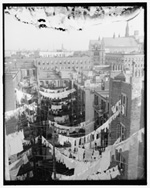Using Visuals to Build Interest and Understanding
 ,
,  ,
, 
Teaching history to English Language Learners poses special challenges owing to its conceptual density and assumed cultural knowledge. It seems obvious that ELLS need additional support and materials to understand content, yet many social studies classrooms are ill-stocked in this regard. Here we outline how visuals can help ELLs build interest and understanding. Rationale Although visuals make excellent learning tools for all students, beginning speakers of English may be able to secure meaning from visual sources they would be incapable of extracting from written sources. By visuals we mean, for example, photographs, graphs, maps, globes, charts, timelines, and Venn diagrams as well as the observation of artifacts and landscapes. Description Consider the following images of tenements at the turn of the 20th century. In the case of New York City, the poor, the unskilled, and in many cases, immigrants, found cheap housing in tenements—rental apartment buildings that were often in disrepair or even unsafe. Large families, or sometimes multiple families, lived in cramped, unhealthy conditions. Infant mortality was high, alcoholism common, and the tenements were a breeding ground for crime. Students can come to understand many of these social phenomena by viewing photographs taken during this time period. Example  [Yard of tenement, New York, N.Y.], c. 1905, Detroit Publishing Company Photograph Collection, Library of Congress: LC-D4-36489 Examine this photograph of a New York City tenement taken between 1900 and 1910 and use the questions to analyze it. The categories used for questioning the sequence is a way to classify stages of speech emergence. The aim is to align linguistic ability with teaching strategies. [See handout.]
[Yard of tenement, New York, N.Y.], c. 1905, Detroit Publishing Company Photograph Collection, Library of Congress: LC-D4-36489 Examine this photograph of a New York City tenement taken between 1900 and 1910 and use the questions to analyze it. The categories used for questioning the sequence is a way to classify stages of speech emergence. The aim is to align linguistic ability with teaching strategies. [See handout.]
New York City Tenement with Laundry: Questioning Strategy Pre-Production
- Where are the buildings in this city? Point to them.
- Point to the laundry (clothes) shown in this photograph.
- Do you see any people in this photograph?
- Was this photo taken during the day or night?
Early Production
- How many clothes lines are there?
- In which buildings do people live?
- Where is this scene taking place?
- In what year, approximately, was this photograph taken?
- During what time of year was this photo likely taken?
Speech Emergence
- What do you see in the distance?
- Why are the clothes hanging on lines outside the buildings?
- Would you like to live in one of these buildings?
- How might this scene look differently today?
Intermediate Fluency
- How is the laundry connected between buildings? Must the people in one building know the people in the buildings on the other side?
- Compare urban housing from 100 years ago to now. How are they similar or different? [Have students create a Venn Diagram of the similarities and difference.]
- Are there cities like this today?
Tenement apartments were also used for work. Already-crowded apartments often doubled as tenement shops, employing as many as 30 workers. Examine this image of an Italian family making artificial flowers in a tenement building:  Ask why people would use their living quarters as both dwelling and workplace. Which family members might be more likely to participate in the work? In conclusion, meaningful historical investigation is an achievable goal for English language learners in the self-contained classroom. While we make no claims that this is a completely painless process for either students or teachers, we have presented ideas on meeting the needs of ELLs while remaining faithful to conceptual learning objectives.
Ask why people would use their living quarters as both dwelling and workplace. Which family members might be more likely to participate in the work? In conclusion, meaningful historical investigation is an achievable goal for English language learners in the self-contained classroom. While we make no claims that this is a completely painless process for either students or teachers, we have presented ideas on meeting the needs of ELLs while remaining faithful to conceptual learning objectives.
For more information
Kathryn Lindholm-Leavy and Graciela Borsato, “Academic Achievement,” in F. Genesee (Ed.), Educating English language learners (New York: Cambridge University Press, 2006), 192.
Cruz & Thornton, "Social Studies for English Language Learners: Teaching Social Studies that Matters," Social Education, in press.
See Cruz & Thornton book, 2009; see also, Jennifer Truran Rothwell, History Making and the Plains Indians, Social Education, 61, no. 1, pp., 4-9, 1996.
 ,
,